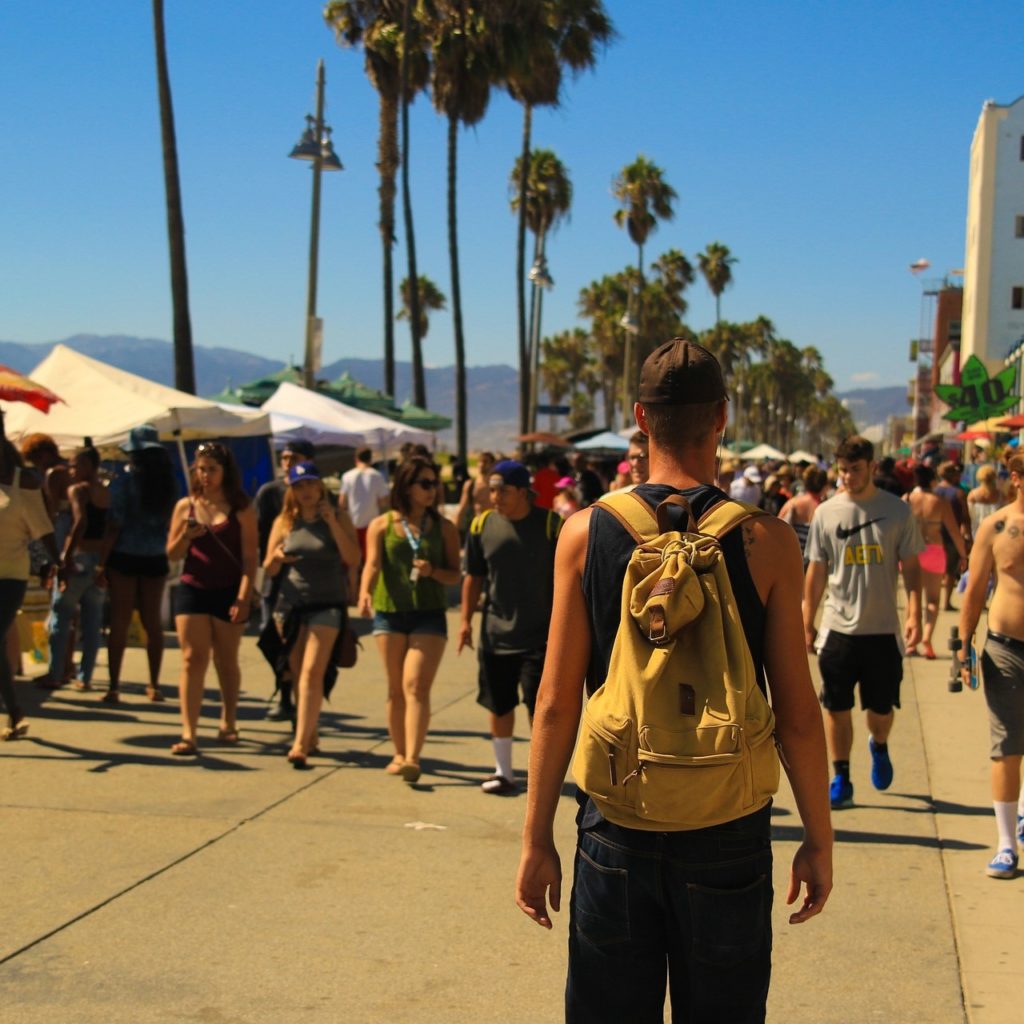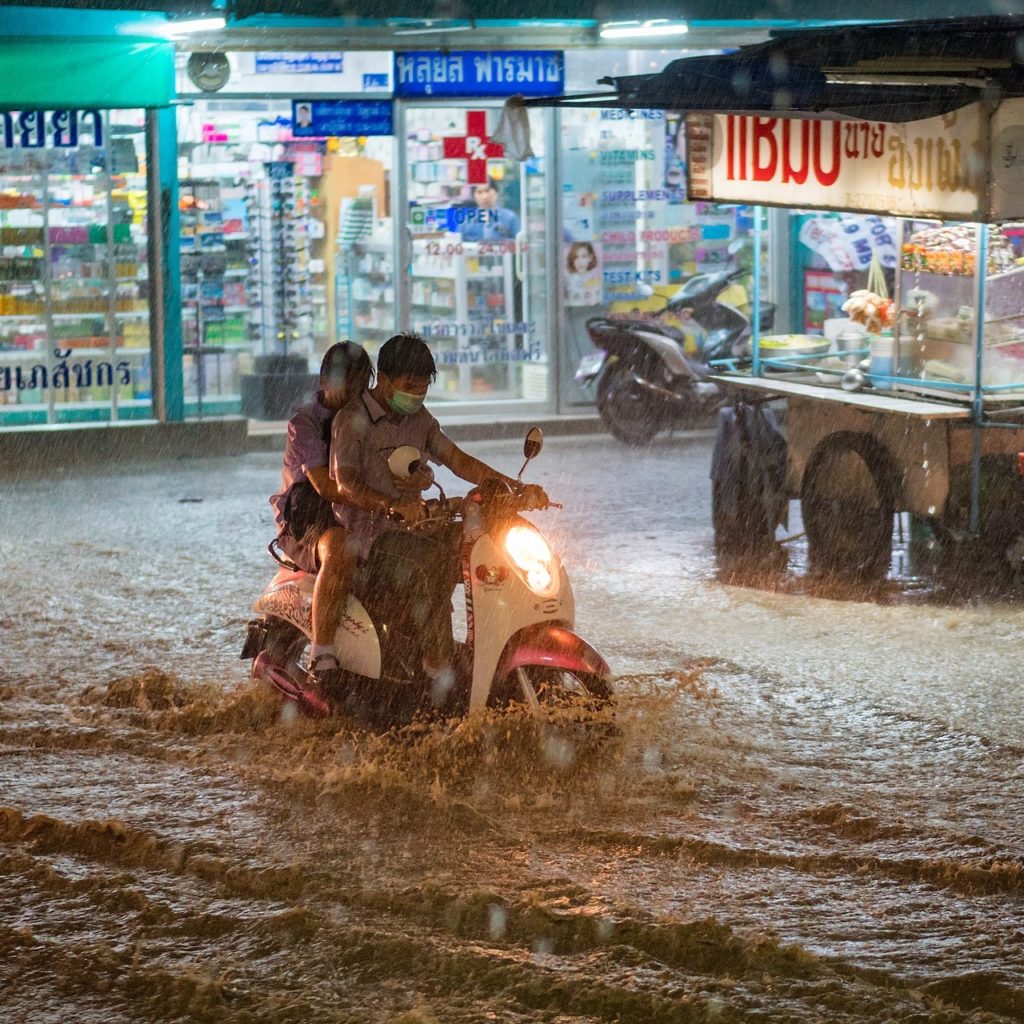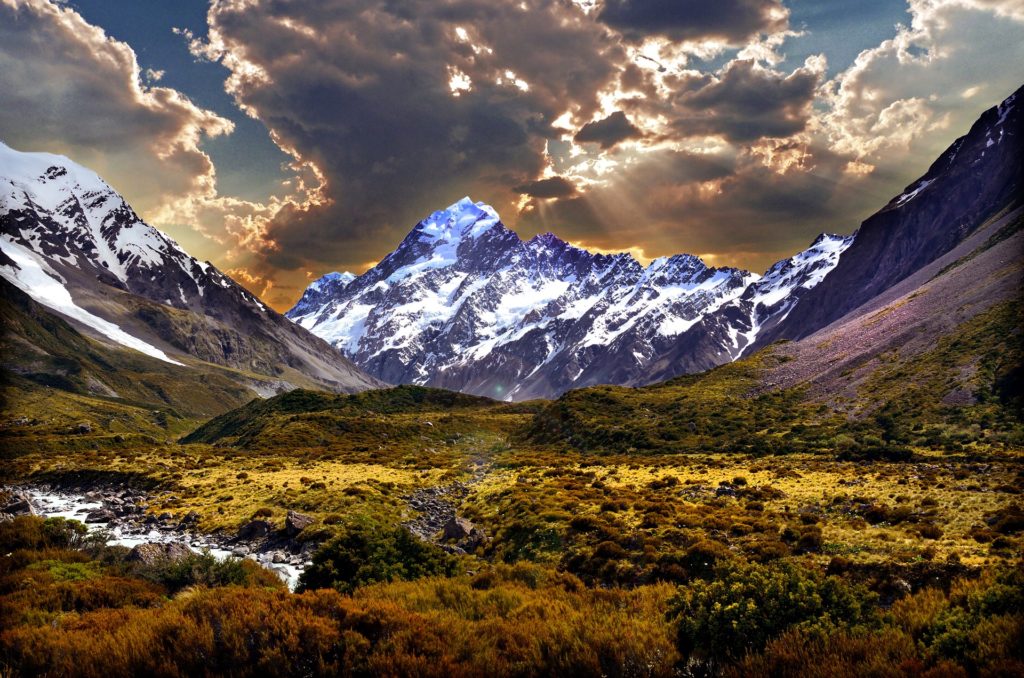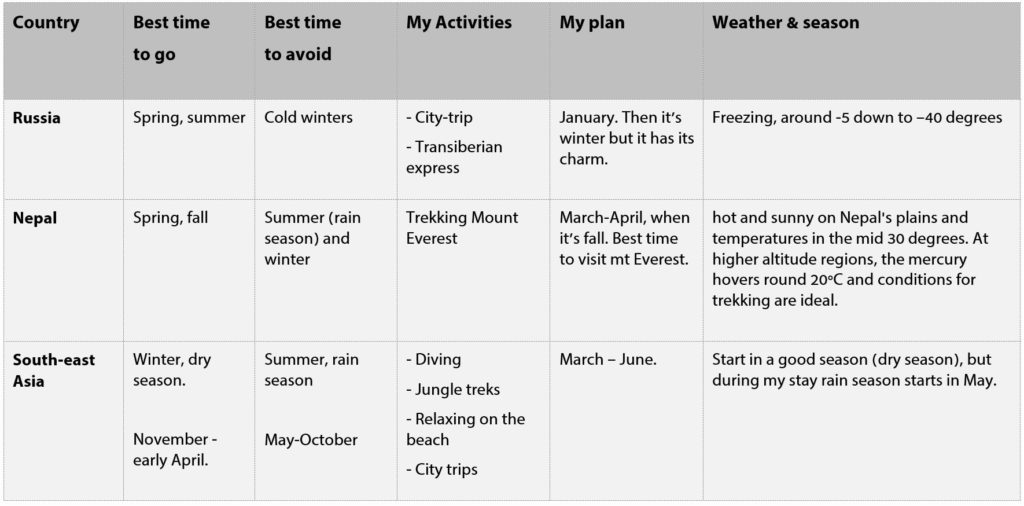Step three: when to go?
So I set the countries I want to visit. Now I need to think about when to set off, where to start and for how long to plan your route. But when is the best time to set off? And which season? Depending on how big your world trip is and how many destinations you want to visit, it can be quite a puzzle to make a good planning. It’s important to do your research Because what if….. you want to climb the Machu Picchu, but when arriving you find out that due to the rain season the park is closed. You don’t want to miss out on something like that, do you? So this is why it’s important to check this and plan your world trip well.
Which season is the best?
Okay first let’s go to the basics. In the world of travel there are three distinct seasons—high, low and shoulder season. And though they’re all rather self-explanatory, it might be productive to shed more light on each. Let’s take a look at the pros and cons of every season, so you can decide which season is the best.
High season
A lot of people can only travel during regular holiday periods. Anyone in university or working in education or with a child in school is limited to travelling during summer or key holiday periods. Travel during these holiday periods is categorized as the high season. The pros of the high season is that the weather conditions are mostly great and that all tourist services are available. You don’t have to worry about a boat tour that’s not available or that a trek to the mount Everest or Machu Picchu is closed due to the rain season. Sounds good right? But there are cons as well, quite big ones actually. First there are large numbers of tourists, which can cause overtourism. Another one, that’s especially a con for backpackers on a budget, are the high prices on products and services. If you can’t avoid high

season then here’s a tip for you: It’s best to avoid travelling to popular destinations during the high season. You will face crowds of people and your savings will vanish quickly. If you plan a trip to lesser-known locations, where few tourists go, then nothing is wrong going there during the high season.

Low season
Well, depending on the region and the things you plan to do, the low season is not that bad. One of the biggest pros are the reduced prices. Accommodation, tours, and food are very cheap. Besides the reduced prices, you have no crowds! The holiday is way more relaxed as there are no lines, traffic jams and most popular spots are empty. The big con is that the low season is generally associated with the worst possible weather in the region. On some days the weather can be so bad that it forces you to stay indoors. For example, in winter you should not go to the Himalayas, as it gets very cold and accidents may happen due to the snowfall. Or, you may not be able to go trekking through the jungle in Indonesia during the rainy season, as the area gets flooded, the path is slippery and the experience becomes dangerous.
Travelling during the low season can definitely save you a lot of money. You can see the popular tourist spots without the crowds and get to interact with the locals more. All you need to do is to prepare yourself accordingly to the bad weather of the region.
Shoulder season
Often the forgotten season. Shoulder season is the season in between high and low season. In some way, it combines the advantages of both of them. Shoulder season usually falls in and around spring and autumn. Many people don’t think about the shoulder season when looking to book their trips. But it is often the best time to visit anywhere. If you go right after high season, you’ll find many of the tourist attractions still open, without the long queues and crowds. Visiting soon after the low season can also be a great option, since you’ll likely still find low prices, as the weather begins to warm up, and the crowds have not yet arrived. You still can make new acquaintances but at the same time enjoy the calm ambience. This season can sometimes mean unpredictable weather patterns, with occasional rain or snowfall, so packing correctly for shoulder season is an important task!

Factors to keep in mind
To plan when you want to start or go to which country there are three factors to keep in mind and they are important to set your own travel schedule.
# 1 - Finance
Let’s talk about money first because, well… for most travelers this is a very important factor and can vary from one traveler to another. If you’re not on a tight budget then you have all the freedom and flexibility to travel from one continent to another and come back just to get the best out of the seasons. And then it doesn’t matter if you go on high or shoulder season. But if you’re like me and – or out of necessity- on a challenge to travel as cheap as possible, you want to travel mostly in shoulder- and low seasons. I choose to travel mostly in shoulder seasons, because I want to save money but in the meantime I have room in my budget and I don’t want to miss out on some great experiences or sites due to money-saving. I don’t want to ruin my dream trip to save just a bit more money. I have enough savings and made many sacrifices before, but not this time!
# 2 - weather
There’s a great, big world out there just waiting to be explored, and all sorts of climates that go along with it. You can experience entire different climates within one country at the same time of the year, depending on the regions you visit. And seasons can vary in every country. For example, Summer (June-August) would be the best time to travel to Russia or European countries, and Winter (December- February) would be the worst. In Asia, South-America or Oceania the situation would be the opposite. When it’s winter in the Netherlands, it’s summer in New Zealand! Besides the weather seasons you also have to keep in mind that we have monsoon, hurricane and drought seasons. Monsoon season in parts of Asia can really put a damper on your trip; northern Europe in November and December is generally cool and wet with short days; and deserts should be avoided during the summer unless you are seeking sunstroke and dehydration. But beyond that, lower prices due to weather are often worth a gamble.
If you’re feeling a little overwhelmed by the sheer variety of destinations, a simple way to narrow down your options is to decide what kind of weather you want to enjoy while on vacation. After all, the weather plays a role in everything from how you experience a given destination, from the food you eat to the activities available at a certain time of year. Whether you prefer a warm holiday or a snowy vacation, the perfect destination for you is out there.
# 3 - Activities
The seasons are generally defined by the weather, but can also depend on the types of travel activities specific to the region. For example, if you want to spend your vacation on a beach in Europe then you’d go there in summer. However, if you want to enjoy skiing, then you’d travel in winter. It also depends on some specific activities you want to do or experience during your trip. For example if you want to walk on Antarctica you need to go there in the summer months (nov-march), because Antarctica is not accessible in other seasons. Or as I described before: if you want to climb the Machu Picchu, the best time is before and after the rain season from late March-April-May, and September-October- early November. If you don’t consider this in your travel plans, there’s a big change you’ll miss out on some great adventures!
Best time to travel in continent....
Now that the tourist seasons make a bit more sense, where should you plan your next trip to? Each continent and each country has its own unique season, and some are perfect holiday destinations all-year-round. Want to read more about the best time to travel in which continent, then click on one of the continents below to read more.
My tips to become a well-seasoned world traveler
1. Be open to a little rain. Do you really mind a bit of cloud and rain if it cuts your bill in half? Find out exactly what rain season means in your destination. In Costa Rica it means 2-4 times a big rain shower that stops after a couple of minutes. I can guess that I’ll probably appreciate a rain shower once or twice a day after a long and warm hike in the tropicals of Costa Rica or when I’m on the beach snorkeling, who cares if I get wet then?
2. Double-check local events and holidays. Chinese New Year might not be a big deal at home, but if half of Asia is travelling and staying in hotels at that time, you might pay double the price for accommodation and domestic flights. If you’re not interested in participating in these events & holidays, it’s best to avoid them.

3. Travel in the shoulder-season. Honestly, if you want to have a good travel schedule and stay on budget, the shoulder season is the best. You get a combination of good weather with the low prices, you avoid the crowds and get closer interaction with the locals.
4. Consider what’s most important. If your main purpose for visiting Nepal is a once-in-a-lifetime ascent of Mount Everest you might want to splurge for the high season rates or else you could find yourself stranded at the base gazing skyward at a raging storm that’s just deprived you of your dream. Sometimes a high season premium can provide a bit of insurance against disappointment.
5. Make a well-seasoned-schedule. This can be quite a hassle. It’s difficult to make a schedule where all destinations come together as a puzzle. Visiting all countries at its best season is probably not possible and you need to make decisions on what’s more important. For example: getting a once-in-a-lifetime experience in Antarctica from December to March, but due to the planning scope you’ll arrive in Central-America in the middle of the rain season …well the daily rain showers after a hot day is fine by me (I might even like it).
I’ll give you an example of my well-seasoned planning to help you start making your own schedule.

Special thanks to Bootsnall.com for all the guidelines and information on how to plan a round-the-world trip!